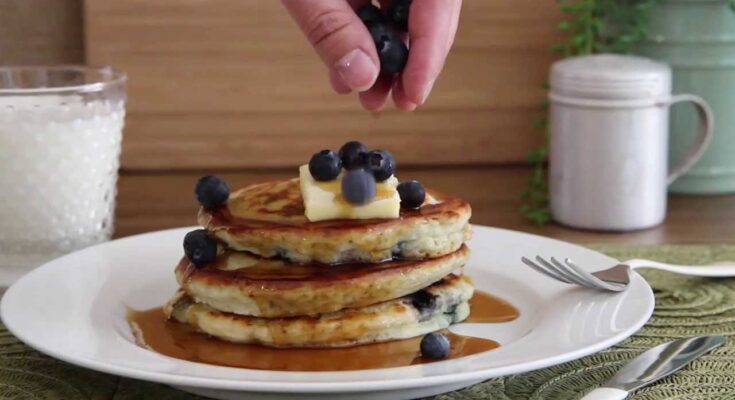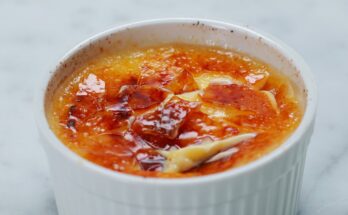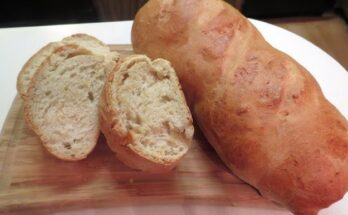Blueberry Pancakes Recipe: There’s nothing quite like the warm, fluffy goodness of blueberry pancakes to kick off your morning. Whether it’s a lazy Sunday brunch or a weekday treat, blueberry pancakes strike the perfect balance between indulgence and comfort food. The slight tartness of the blueberries pairs perfectly with the soft, buttery pancake base, making it a crowd-pleaser for kids and adults alike. If you’re someone who thinks pancakes from a box mix are the only way to go, think again. Homemade blueberry pancakes are not only easy to make but also much more flavorful and satisfying.
Why choose blueberry pancakes over the regular ones? It’s all about the experience. Blueberries add bursts of flavor and antioxidants to each bite, making your pancakes not just delicious but also a tad healthier. Plus, their juicy texture contrasts beautifully with the soft pancakes, creating a melt-in-your-mouth sensation that’s simply irresistible. Once you try this homemade recipe, you’ll never want to go back to pre-made mixes again.
In this guide, we’ll walk you through every step of making blueberry pancakes from scratch. From gathering your ingredients to flipping the perfect golden brown pancake, we’ve got you covered. Whether you’re a beginner or a seasoned home cook, this guide will help you master the art of blueberry pancakes.
Ingredients You’ll Need
A good pancake starts with good ingredients. For blueberry pancakes, you need a mix of pantry staples and a few special additions. Here’s what you’ll need:
Dry Ingredients
- 1 ½ cups of all-purpose flour
- 2 tablespoons of granulated sugar
- 1 tablespoon of baking powder
- ½ teaspoon of baking soda
- ½ teaspoon of salt
These dry ingredients form the base of your pancake batter. The flour provides structure, the sugar adds a hint of sweetness, and the baking powder and baking soda give the pancakes their signature fluffiness. Don’t skip the salt—it enhances all the other flavors and balances the sweetness from the blueberries and syrup.
Wet Ingredients
- 1 ¼ cups of buttermilk (or whole milk with 1 tbsp vinegar as a substitute)
- 1 large egg
- 2 tablespoons of melted unsalted butter (plus more for the pan)
- 1 teaspoon of vanilla extract
The wet ingredients are key to creating a smooth, lump-free batter. Buttermilk is a classic choice because it adds tang and reacts well with the baking soda for that airy texture. The egg helps bind everything together, while the melted butter adds richness. Vanilla extract gives your pancakes a subtle aromatic boost.
Optional Add-ons
- 1 cup of fresh or frozen blueberries
- Zest of one lemon (for added zing)
- A pinch of cinnamon (for warmth)
- Maple syrup and extra butter for serving
Fresh blueberries are preferred for their firmness, but frozen ones work just as well—just don’t thaw them before adding to the batter. Lemon zest can brighten the flavor, and cinnamon adds a cozy twist. These are totally optional, but they can elevate your pancakes to gourmet status.
Tools Required
You don’t need a fancy kitchen setup to make amazing pancakes. Just a few basic tools will get the job done.
Kitchen Utensils
- Large mixing bowl
- Measuring cups and spoons
- Whisk or fork
- Ladle or measuring cup (for pouring batter)
- Spatula (preferably non-stick)
These simple tools are enough to whip up a smooth batter and handle the pancakes on the griddle. A whisk helps avoid clumps in your batter, and a rubber spatula makes folding in blueberries easier without crushing them.
Cooking Appliances
- Non-stick frying pan or griddle
- Stove or electric griddle
- Cooling rack (optional)
A non-stick pan is your best friend here. It ensures even cooking and minimizes the chances of your pancakes sticking or tearing. If you’re cooking for a crowd, a griddle can help speed things up by allowing you to cook multiple pancakes at once. A cooling rack isn’t essential, but it keeps pancakes from getting soggy if you’re stacking them while cooking the rest.
Preparing the Batter
Making the batter is the heart of the process. The key is not to overmix—pancake batter should be slightly lumpy and thick but pourable.
Mixing Dry Ingredients
Start by sifting or whisking together all your dry ingredients in a large bowl. This step helps to evenly distribute the baking powder, baking soda, salt, and sugar throughout the flour. It might be tempting to skip sifting, but trust us—it makes a noticeable difference in texture.
If you’re adding any spices like cinnamon, include them here. Same goes for lemon zest if you’re going for that extra citrusy touch. Mix thoroughly to ensure everything is well incorporated.
Combining Wet and Dry Mixtures
In a separate bowl, whisk together your wet ingredients: buttermilk, egg, melted butter, and vanilla extract. Make sure the melted butter isn’t too hot when adding it—otherwise, it could scramble the egg. Once combined, pour the wet mixture into the bowl with your dry ingredients.
Here’s the trick: gently fold the mixture with a spatula or wooden spoon until just combined. Do not overmix! A few lumps are perfectly okay. Overmixing will lead to dense, rubbery pancakes, and nobody wants that.
Gently Folding in Blueberries
Now comes the best part—adding the blueberries. If you’re using fresh ones, rinse and pat them dry before folding them in. If using frozen, toss them with a teaspoon of flour first. This prevents them from sinking to the bottom and bleeding color into the batter.
Use a soft hand to fold in the blueberries, just until they’re evenly distributed. At this point, your batter is ready to go. Let it sit for 5 minutes while you heat your pan. This short rest allows the gluten to relax and the baking powder to activate, resulting in fluffier pancakes.
Cooking the Pancakes
Heating the Pan Correctly
Getting your pan to the right temperature is crucial. Set your stove to medium heat and let the pan warm up for about 3–5 minutes. You can test if it’s ready by sprinkling a few drops of water onto the surface—if they sizzle and evaporate almost immediately, you’re good to go. Add a small amount of butter or oil to the pan and swirl to coat. This not only prevents sticking but also adds a rich, golden-brown color to the pancakes.
Avoid using too much butter, as it can burn and leave a bitter taste. A light coating is all you need. For every new batch, you can reapply a little butter to keep things smooth and flavorful.
Portioning the Batter
Use a ladle, large spoon, or 1/4 cup measuring cup to pour the batter onto the hot pan. Keep the pancakes spaced apart, especially if you’re cooking multiple at once. This allows for easier flipping and avoids them merging into one massive, oddly shaped pancake. You’ll notice bubbles starting to form around the edges—that’s your signal that it’s almost time to flip.
If you want picture-perfect round pancakes, gently shape the batter right after pouring it onto the pan using the back of your ladle or spoon.
Flipping Like a Pro
Now, here’s the moment of truth—flipping your pancakes. When you see bubbles forming on the surface and the edges start looking set, slide your spatula underneath and flip it in one quick motion. Try to do it confidently; hesitation can result in uneven flipping.
Cook the second side for another 1–2 minutes until golden brown. Avoid pressing down on the pancake with your spatula—it may seem tempting, but doing so squeezes out all the fluffy air and leaves you with a flat, dense pancake.
Repeat this process until all the batter is used up, keeping the cooked pancakes warm on a plate covered with foil or in a 200°F oven.
Serving Suggestions
Classic Toppings
Once your pancakes are done, it’s time for the fun part—serving them up. You can never go wrong with the classics: a generous pat of butter melting over the top and a drizzle of real maple syrup. The syrup soaks into the pancakes, balancing the sweetness of the blueberries and the richness of the batter.
Add a handful of extra blueberries on top for a burst of freshness or sprinkle with a light dusting of powdered sugar to make them look bakery-ready.
Creative Twists
Feeling a little adventurous? Try adding whipped cream and a sprinkle of granola for a crunchy, creamy bite. Or make it a dessert pancake with a scoop of vanilla ice cream, chocolate chips, and a berry compote on top. For a slightly tangy twist, serve with Greek yogurt and honey. These little variations can turn a simple breakfast into a gourmet experience.
Drinks That Pair Well
Pair your blueberry pancakes with fresh orange juice for a zesty contrast or a warm mug of coffee for a classic breakfast vibe. If you’re serving brunch, consider offering mimosas or berry smoothies for a fun, flavorful match.
Storage and Reheating Tips
Storing Leftovers
Got extras? No worries. Let the pancakes cool completely before stacking them between layers of parchment paper. Then store them in an airtight container or resealable bag. They’ll keep in the fridge for up to 4 days or in the freezer for up to 2 months.
Label your containers with the date so you know how long they’ve been stored. You’ll thank yourself later.
Reheating for Freshness
To reheat, pop them in the toaster or warm them in the oven at 350°F for about 10 minutes. Microwaving is also an option, but it can make the pancakes a bit soggy if not done right. If you do use the microwave, wrap them in a paper towel and heat in 20-second bursts.
Freezer pancakes can go straight into the toaster. This method brings back that crispy edge while keeping the center soft and fluffy—just like fresh.
Common Mistakes to Avoid
Overmixing the Batter
This is the number one sin in pancake-making. Stirring too much activates the gluten in the flour, which can lead to tough, chewy pancakes. Mix until just combined—lumps are okay and even desirable.
Using a Too-Hot Pan
If your pan is smoking or burning the butter, it’s way too hot. High heat might cook the outside quickly but leave the inside undercooked. Medium heat gives you control and consistent results every time.
Flipping Too Early
If you flip too soon, the batter will splatter and break apart. Wait until bubbles form and the edges are firm. Rushing this step can ruin your pancakes’ shape and texture.
Healthier Variations of Blueberry Pancakes
Whole Wheat and Oat Options
Want to make your blueberry pancakes a bit healthier without sacrificing flavor? Swap out the all-purpose flour for whole wheat flour or oat flour. Whole wheat adds fiber and a hearty texture, while oat flour gives a slightly nutty taste that pairs beautifully with blueberries.
You can even use a 50/50 blend of whole wheat and all-purpose flour for a lighter feel while still getting those extra nutrients. Adding a tablespoon of ground flaxseed or chia seeds is another easy way to boost the fiber and omega-3 content in your breakfast.
Dairy-Free and Vegan Alternatives
No dairy? No problem. Replace buttermilk with almond milk, oat milk, or soy milk. For a buttermilk substitute, just add a teaspoon of vinegar or lemon juice to your plant-based milk and let it sit for 5 minutes before using. For the egg, use a flax egg (1 tablespoon ground flaxseed + 3 tablespoons water) or a commercial egg replacer.
Vegan butter or coconut oil can stand in for regular butter, and the rest of the ingredients are naturally plant-based. You’ll still get golden, fluffy pancakes with the added bonus of being vegan-friendly.
Low-Sugar or Gluten-Free Versions
If you’re watching your sugar intake, reduce or skip the sugar entirely in the batter. The blueberries add natural sweetness, and a drizzle of maple syrup on top can compensate for less sugar in the pancake itself.
For gluten-free pancakes, use a 1:1 gluten-free flour blend. You can also try almond flour or a mix of coconut and rice flour, though you may need to adjust the liquid levels. Gluten-free batters can be trickier to work with, but the results are still delicious when done right.
Tips for Fluffy and Delicious Pancakes
Don’t Skip the Resting Time
Letting your pancake batter rest for about 5 to 10 minutes before cooking gives the gluten time to relax and the baking powder time to activate. This results in lighter, fluffier pancakes that puff up beautifully when cooked.
Use Fresh Baking Powder
Baking powder loses its potency over time. If your pancakes are turning out flat, your leavening agents might be the culprit. Replace your baking powder every 6 months for best results.
Avoid Overcrowding the Pan
Give each pancake enough space to cook and expand. Overcrowding leads to uneven cooking and makes flipping difficult. Stick to 2–3 pancakes at a time, depending on the size of your pan or griddle.
Warm the Syrup
A small but powerful tip—warm your maple syrup before pouring it over your pancakes. Cold syrup can make your pancakes soggy and bring down the temperature. A few seconds in the microwave or a quick warm-up on the stove can make a world of difference.
Make-Ahead and Freezer-Friendly Options
Preparing Pancake Mix in Advance
You can save time by mixing the dry ingredients in advance and storing them in an airtight container. This homemade “instant” mix can be kept for several weeks. When you’re ready to make pancakes, just add the wet ingredients and blueberries.
Label your container with mixing instructions so everything’s ready to go. It’s perfect for busy mornings or lazy weekends.
Freezing Pancakes for Later
After cooking, let the pancakes cool completely. Stack them with parchment paper between each one and store them in a freezer bag. When sealed properly, they can last up to two months.
To reheat, you can use a toaster, oven, or even an air fryer. This keeps them crispy on the outside and soft on the inside. You can also microwave them if you’re in a rush, though they might be softer.
Batch Cooking for Meal Prep
Make a double or triple batch and freeze the extras. Having pancakes on hand can be a lifesaver for quick breakfasts. Add fresh toppings or new sides to keep things interesting. You can even turn them into pancake sandwiches with nut butter and fruit in the middle.
FAQs about Blueberry Pancakes Recipe
1. Can I use frozen blueberries instead of fresh ones?
Yes! Frozen blueberries work just as well. Don’t thaw them beforehand—just toss them in with a bit of flour to prevent them from sinking or bleeding color.
2. Why are my pancakes not fluffy?
You might be overmixing the batter or using old baking powder. Letting the batter rest and ensuring your leavening agents are fresh can help.
3. How do I keep pancakes warm while cooking the rest?
Place them on a baking sheet in a 200°F (90°C) oven while you finish cooking the rest.
4. Can I make the batter the night before?
Yes, but add the baking powder right before cooking for the fluffiest results. Store the batter in the fridge in an airtight container.
5. What’s the best way to reheat frozen pancakes?
Use a toaster or oven to keep them crispy. Microwaving is faster but can make them soft.
Conclusion
There you have it—your ultimate guide to making blueberry pancakes from scratch. From gathering the perfect ingredients to mastering the flip, these tips and tricks will help you make pancakes that are fluffy, flavorful, and unforgettable. Whether you stick to the classic version or explore healthier and vegan alternatives, blueberry pancakes are a delicious way to bring people together for a cozy, satisfying meal. So heat up that pan, pour the batter, and let the sweet aroma fill your kitchen. Your perfect stack of blueberry pancakes is just a flip away!



